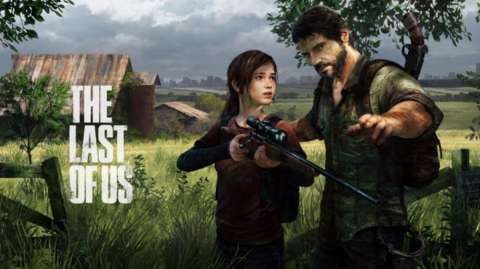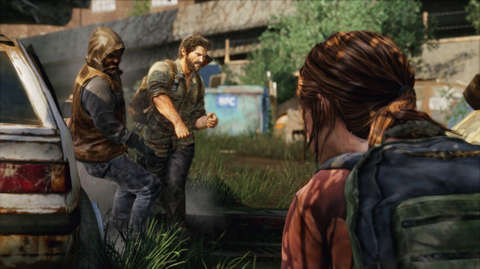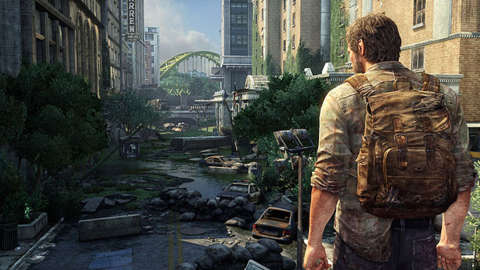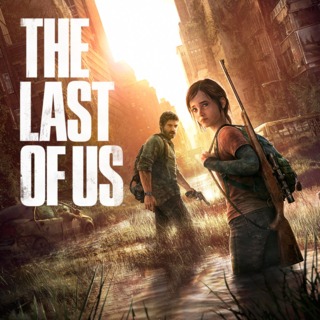Pros:
+ engaging, impactful story in a relentlessly brutal setting
+ excellent voice acting and well-realized characters
+ tense, dynamic, open-ended combat
+ limited resources and crafting require strategy and adaptability
+ beautiful environments with details that further flesh out the world
+ strategic gameplay translates well to multiplayer
Cons:
- AI problems break immersion
- a few continuity issues
Sometimes it’s easy to dismiss the big-budget video game market as derivative or lacking innovation, relying too much on sequels and tired tropes. Take a quick glance at The Last of Us, and you might think it just another cog in the machine. Another third-person action game with shooting. Another post-apocalyptic zombie game. But The Last of Us takes a conventional game genre and premise and marries them to an intensely personal, dark story with thematically consistent gameplay. What’s left doesn’t revolutionize storytelling in games, but raises the bar as a deeply affecting, cohesive experience and one of the best games to grace the PlayStation 3.
The Last of Us stars Joel, a cold-hearted survivor of the game’s cold-hearted world. The story starts on the day society falls to the cordyceps pandemic, which infects sixty percent of the population, turning people into violent monsters sprouting slowly expanding fungal growths. Governments aren’t prepared for the outbreak, and they hastily set up military-run quarantine zones while the infected ravage most cities and suburbs. Overnight, civilization is devastated as families are slaughtered or infected and lives are torn apart. Fear spreads as rapidly as the infection, and people quickly learn to do whatever it takes to survive, or else perish.

After the intro, the game flashes forward to twenty years after the outbreak. Joel has learned to survive; he has become a smuggler and has formed alliances to support himself. After some complicated circumstances among conflicting factions of survivors, Joel is tasked with escorting Ellie, a fourteen-year-old girl, out of Boston and eventually across the United States. The post-apocalypse is the only world Ellie knows, so she exhibits a surprising degree of boldness and maturity. Yet she still represents innocence in a shattered world, as she occasionally whips out a book of puns, practices whistling, muses about the trivial troubles of the past, and truly hopes for the future despite losing all those near to her. Joel provides an excellent foil; he’s a man haunted and broken by his loss and cares only for the present and his own survival. While Ellie aims to come to terms with loss, Joel refuses to acknowledge emotion, looking only for ways to make it to the next day no matter the cost of life or morals. It’s easy to invest your emotions in these relatable characters because their actions and words are consistent with their motivations and development, and the performances expertly bring them to life. As you watch the unlikely duo slowly grow to trust each other, you’ll yearn for their survival and for Ellie’s warmth and humanity to rub off on Joel. The dynamic between Joel and Ellie is the best developed character relationship in all of games and is the driving force of the game’s well-paced fifteen-hour run time.
The dynamic between Joel and Ellie is the best developed character relationship in all of games and is the driving force of the game’s well-paced fifteen-hour run time.
Over the course of Joel and Ellie’s adventure, the pair meets various bands of survivors, who each have a different reaction to the infection. Some people rely on the harsh militia of the surviving quarantine zones for safety. Many others form their own communities. While some groups do their best to build stable social structures and support each other, others are loose bands of hunters who viciously plunder anyone who enters their territory. One man secludes himself from the rest of the population, hording supplies and constructing booby traps to protect him from both the infected and thieves. Seeing these different takes on survival flesh out a brutal world where some forsake all hope and morals and others desperately cling on to humanity, hoping and searching for a cure to the infection. The Last of Us looks at the good, bad, and gray aspects of humanity by putting complex characters in complex situations that force them to either make sacrifices or match the cruelty of its world. The Last of Us is relentlessly dark and emotionally exhausting, even when you can accurately predict where it’s going. You might know a character that won’t make it when you see one, but the story always exceeds your emotional expectations even if it meets your expectations of the plot. The game’s believable world and sharp performances make every violent, sad scene hit hard in your gut and every brief spark of hope shimmer in your stomach.
The game’s believable world and sharp performances make every violent, sad scene hit hard in your gut and every brief spark of hope shimmer in your stomach.
Such a fantastic story is an impressive achievement in itself, but gameplay that matches the emotions and enhances the effect of the plot further cements The Last of Us as a masterpiece. Both survivors and infected often stand in Joel and Ellie’s way on their trek west, and you’ll be able to deal with them in a number of ways. Like games such as Dishonored and Metal Gear Solid 4, you have the choice of taking enemies head on or using stealth to take them down. And occasionally you’ll have the option of avoiding combat altogether. Unlike those other games, however, The Last of Us incentivizes stealth by limiting your resources. The best way to conserve ammo and supplies is laying low and choking out your enemies. This approach is often difficult because enemies are always on the move, and choking someone out takes a few seconds, leaving you vulnerable to hostiles nearby.
A silent run can be going so well, you having used bricks and bottles to distract or stun enemies before you shove breakable shivs in their necks or shoot arrows in their heads. But just as you shuffle back into cover, a guard sees you and sounds the alarm. In these situations, you can’t just shoot your way out of trouble. Your aim sways, you have too little ammo to afford many mistakes, and you’ll die quickly when you’re surrounded in the open. The game usually gives you just enough resources to scrape by in a fight and doles out new types of weapons at an enticing pace as encounters get tougher. A great crafting system forces you to scrounge the environments both in and out of combat for materials such as blades, binding, and alcohol. With them, you can create health kits, extra shivs, and homemade explosives. You’ll procure an impressively varied arsenal of guns, crafted items, and objects in the environment such as bricks and wooden planks, but the strict limits of how much of each item you can carry force you to experiment with all options, both in stealth and in the open. You’ll likely pummel someone with a two-by-four before planting a motion-triggered bomb and running to faraway cover to patch yourself up. You might be able to get back into stealth and choke out a few more enemies before using a Molotov cocktail to finish off the last bloodthirsty survivor. These fights are dynamic and fluid, often leaving you with very little health and very little bullets after several failed attempts of clearing an area.

Similarly exhausting are the encounters with the infected, but they often require a harsher dedication to stealth. When one zombie catches you out, a whole pack swarms and mauls you in seconds. Someone who’s been infected for years becomes a clicker, a blind monster with acute hearing and a gross fungus covering its head. You can walk in front of these horrors without being seen, but they can hear your footsteps even when you’re crouching. They also kill in one bite, so you need to take care in moving around quickly and quietly while using throwable objects as distractions. Creeping up on a slow, limping clicker only to have it turn around and screech, echoed by the blood-curling screams of nearby infected is a terrifying experience often resulting in death.
By requiring smart use of resources, time, and the level design, the gameplay reinforces the idea that to survive in such a cruel world, you must be clever and often brutal.
Despite being incredibly varied and satisfying to conquer, combat encounters aren’t necessarily fun. They’re slow, stressful, and hard. This is by no means a bad thing. Exhausting gameplay mirrors an exhausting world. Combat in The Last of Us is just as emotionally draining as its story. The game puts you in these tough situations to help you sympathize with the characters’ struggles in a world of constant danger. By requiring smart use of resources, time, and the level design, the gameplay reinforces the idea that to survive in such a cruel world, you must be clever and often brutal.
The artificial intelligence of both companions and enemies is the major culprit of breaking your immersion.
Though the gameplay as a whole does a great job of connecting you to this bleak vision of humanity, some issues can easily take you out of the experience. The artificial intelligence of both companions and enemies is the major culprit of breaking your immersion. Ellie might randomly run out in the open or crouch inches from a guard, and neither party would be particularly bothered. This could be considered a good thing because otherwise, you would have to account for both your actions and Ellie’s, likely compromising stealth as a feasible option. However, seeing a hostile walk straight past Ellie is silly and can kill the tense mood of combat. You might also catch a guard running in circles for no apparent reason and another jumping through solid walls as if there were an open window. The game’s continuity also suffers from “game-y” sequences. In a flooded subway station, Ellie tells Joel she can’t swim. After going ahead and diving under some wreckage, you resurface to find Ellie inexplicably on a platform surrounded by water. There are also a few sequences where Joel suddenly acquires infinite ammo. These problems aren’t game-breaking, but they do dilute the impact of specific moments in the game’s otherwise detailed and realistic world.

Part of that realism comes from the way The Last of Us looks. Though the game’s art direction is fairly typical of post-apocalyptic settings, with foliage growing through concrete, architecture in ruins, and long-abandoned cars sprawled over roads, the technical proficiency of the graphics and many little touches make the world all the more believable. Graceful animations and facial details further ground the characters’ actions and words. A mostly intact record store fully stocked with vinyl, a college dormitory littered with ripped posters, and decrepit suburban homes complete with children’s bedrooms and backyard barbecues indicate that normalcy once existed in this world. People didn’t always have to worry about their neighbor shooting their heads off or whether or not a family member would survive scavenging for food. Every place in The Last of Us tells a story. In the down times in between combat, you have the freedom to explore the environments to find materials for crafting or upgrading your skills and weapons. Along the way, you’ll notice environmental details that show how a community might have lived, such as a homemade soccer net in a forsaken makeshift town in a sewer. You’ll also find notes in the environments, sometimes direct letters between struggling survivors or a log of food collected per month. The bits of exploration let the game’s pace breathe from the taxing combat and emotional plot climaxes and also provide further perspective on survival and the sacrifices those already gone have made.
Like in the campaign, experimenting on the fly is important, and success with different techniques can make you feel like a master of survival.
The desperation of the game’s combat surprisingly translates well to multiplayer, providing a unique take on standard online shooters. In multiplayer, you choose a faction and start a clan, collecting food, supplies, and new members until an extraction team reaches you in twelve weeks. Each online match counts for a day, and your performance affects how your clan holds up. You need to collect a certain amount of supplies during a match, which you obtain from corpses you kill and from completing certain tasks. If you exceed the requirement, more members will join your clan, and if you don’t meet it, members will get hungry or sick and may eventually die if you continue to perform poorly. This meta-game is an interesting incentive to better your skills and build up your clan in order to get unlocked abilities and weapons. As for the matches themselves, the types are fairly standard, but you’re rewarded for playing slowly and methodically and working with your teammates. Stealth and crafting are as essential in multiplayer as they are in the single-player because shooting and sprinting mark you on the radar. It’s exhilarating to see an opponent walk into your bomb trap before you rush to execute him before the other team can revive him. Like in the campaign, experimenting on the fly is important, and success with different techniques can make you feel like a master of survival.
The Last of Us isn’t afraid to explore humanity’s core, and it finds there hearts of darkness among hearts of gold. The emotional turmoil of Joel and Ellie’s journey will stick with you, as will the complex, desperate world in which they live. But The Last of Us will be lauded for decades not only for its strong story and rich setting, but also for making your interactions with its world meaningful in understanding the struggles of its inhabitants. There’s no one part of The Last of Us that’s revolutionary to games, but rather every piece is exceptionally done and made to agree with the experience as a whole. The few moments when it falters are overshadowed by the game’s excellent character development, gameplay triumphs, and ability to infect your mind long after you put the controller down.

